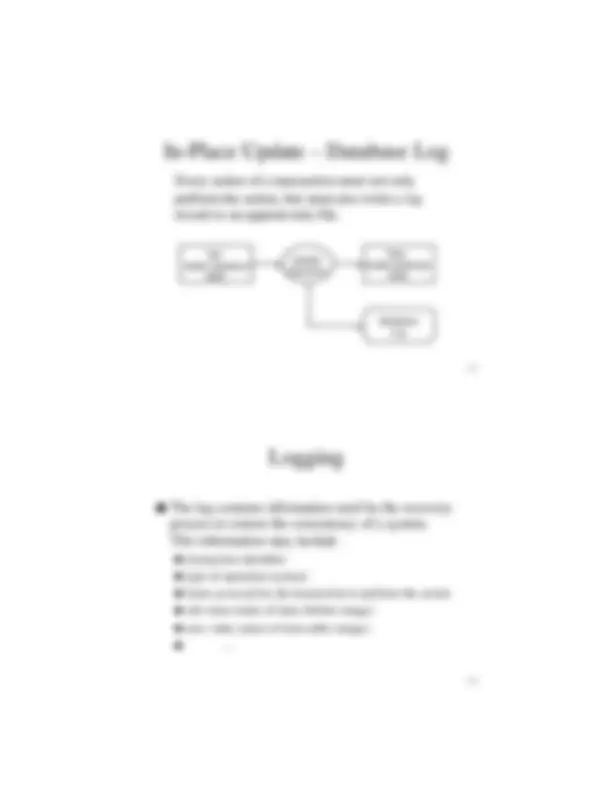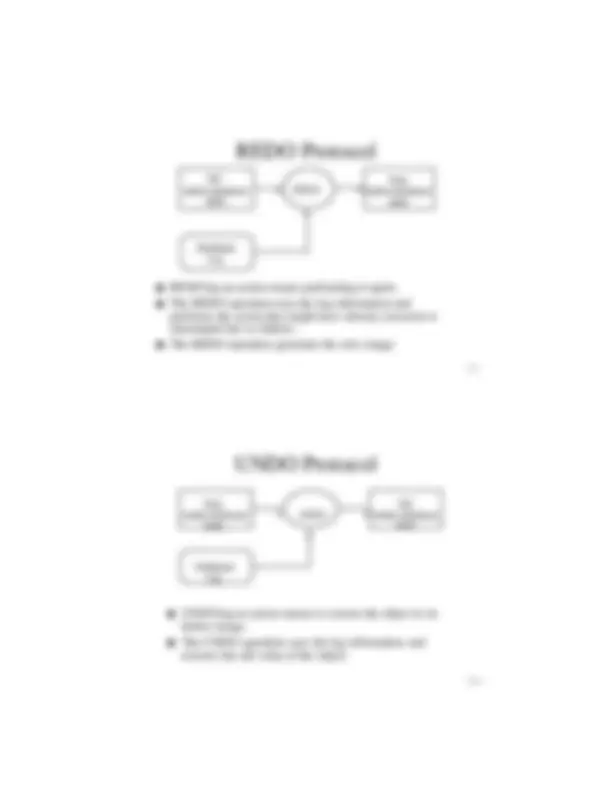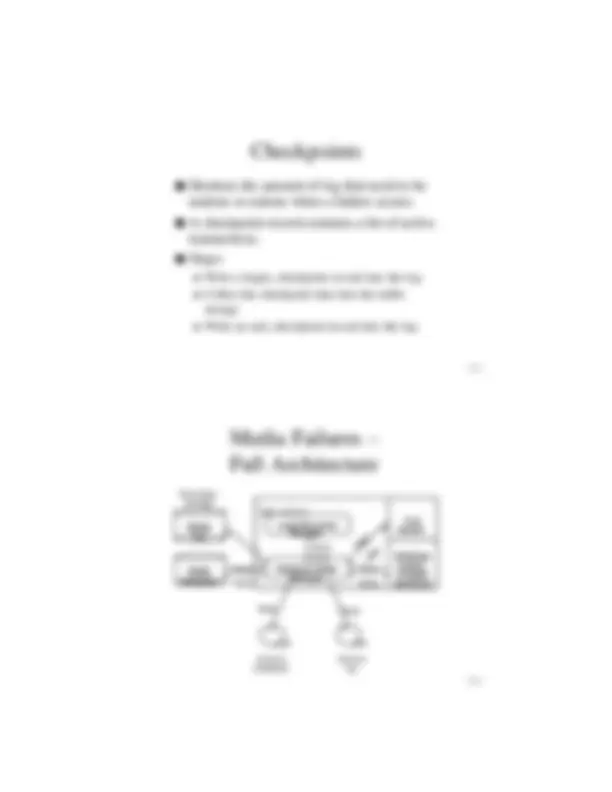








Study with the several resources on Docsity

Earn points by helping other students or get them with a premium plan


Prepare for your exams
Study with the several resources on Docsity

Earn points to download
Earn points by helping other students or get them with a premium plan
Community
Ask the community for help and clear up your study doubts
Discover the best universities in your country according to Docsity users
Free resources
Download our free guides on studying techniques, anxiety management strategies, and thesis advice from Docsity tutors
The importance of maintaining atomicity and durability properties of transactions in databases. It covers different types of failures and their recovery management, including in-place and out-of-place updates, logging, and write-ahead log protocol. The document also explains the role of the recovery manager and buffer manager in managing database transactions.
Typology: Slides
1 / 10

This page cannot be seen from the preview
Don't miss anything!







10-
Problem:
How to maintain
atomicity
durability
properties of transactions
n Transaction failures
l Transaction aborts (unilaterally or due to deadlock) l Avg. 3% of transactions abort abnormally
n System (site) failures
l Failure of processor, main memory, power supply, … l Main memory contents are lost, but secondary storage contents are safe l Partial vs. total failure
n Media failures
l Failure of secondary storage devices such that the stored data is lost l Head crash/controller failure
10-
n Volatile storage l Consists of the main memory of the computer system (RAM). n Stable storage l Resilient to failures and loses its contents only in the presence of media failures (e.g., head crashes on disks). l Implemented via a combination of hardware (non-volatile storage) and software (stable-write, stable-read, clean-up) components.
Secondary storage
Stable database
Read (^) Write Write Read
Recovery^ Main memory Manager
Database Buffer Manager
Fetch, Flush (^) Database buffers (Volatile database)
Transaction commands
l Each update causes a change in one or more data values on pages in the database buffers
l Each update causes the new value(s) of data item(s) to be stored separate from the old value(s). l Shadowing ‡ When an update occurs, don't change the old page, but create a shadow page with the new values and write it into the stable database. ‡ Update the access paths so that subsequent accesses are to the new shadow page. ‡ The old page retained for recovery.
10-
T 1 , begin T 1 , x , 99, 100 T 2 , begin T 2 , y , 199, 200 T 3 , begin T 3 , z , 51, 50 T 2 , w , 1000, 10 T 2 , commit T 4 , begin T 3 , abort T 4 , y , 200, 50 T 5 , begin T 5 , w , 10, 100 T 4 , commit
Log head
Log tail
l all of T 1 's effects should be reflected in the database (REDO if necessary due to a failure) l none of T 2 's effects should be reflected in the database (UNDO if necessary)
0 t time
system crash Begin^ T 1 End Begin T 2
10-
n REDO'ing an action means performing it again.
n The REDO operation uses the log information and performs the action that might have already executed or interrupted due to failures.
n The REDO operation generates the new image.
Database Log
REDO
Old stable database state
New stable database state
n UNDO'ing an action means to restore the object to its before image. n The UNDO operation uses the log information and restores the old value of the object.
New stable database state
Database Log
UNDO
Old stable database state
10-
l If a system crashes before a transaction is committed, then all the operations must be undone. Only need the before images ( undo portion of the log).
l Once a transaction is committed, some of its actions might have to be redone. Need the after images ( redo portion of the log).
∂ Before a stable database is updated, the undo portion of the log should be written to the stable log ∑ When a transaction commits, the redo portion of the log must be written to stable log prior to the updating of the stable database.
n Can the Buffer Manager (BM) decide to write some of the buffer pages being accessed by a transaction into stable storage or does it wait for Recovery Manager (RM) to instruct it? l steal/no-steal decision l no-steal means RM “pins” (or “fixes”) pages in the buffer n Does the RM force the BM to write certain buffer pages into stable database at the end of a transaction's execution? l force/no-force decision n Possible execution strategies: l steal/no-force l steal/force l no-steal/no-force l no-steal/force
10-
l BM may have written some of the updated pages into stable database l RM performs transaction undo (or partial undo)
l RM writes an “commit” record into the log.
l For those transactions that have both a “begin” and an “commit” record in the log, a partial redo is initiated by RM l For those transactions that only have a “begin” record in the log, a global undo is executed by RM
l BM may have written some of the updated pages into stable database l RM performs transaction undo (or partial undo)
l RM issues a flush command to the buffer manager for all updated pages l RM writes a “commit” record into the log.
l No need to perform redo l Perform global undo
10-
∂ Write a begin_checkpoint record into the log ∑ Collect the checkpoint data into the stable storage ∏ Write an end_checkpoint record into the log
Read Write Write
Read
Main memory Local Recovery Manager
Database Buffer Manager
Fetch, Flush
Archive log
Archive database
Secondary storage
Stable log
Stable database
Database buffers (Volatile database)
Log buffers
Write (^) Write
Write
Read